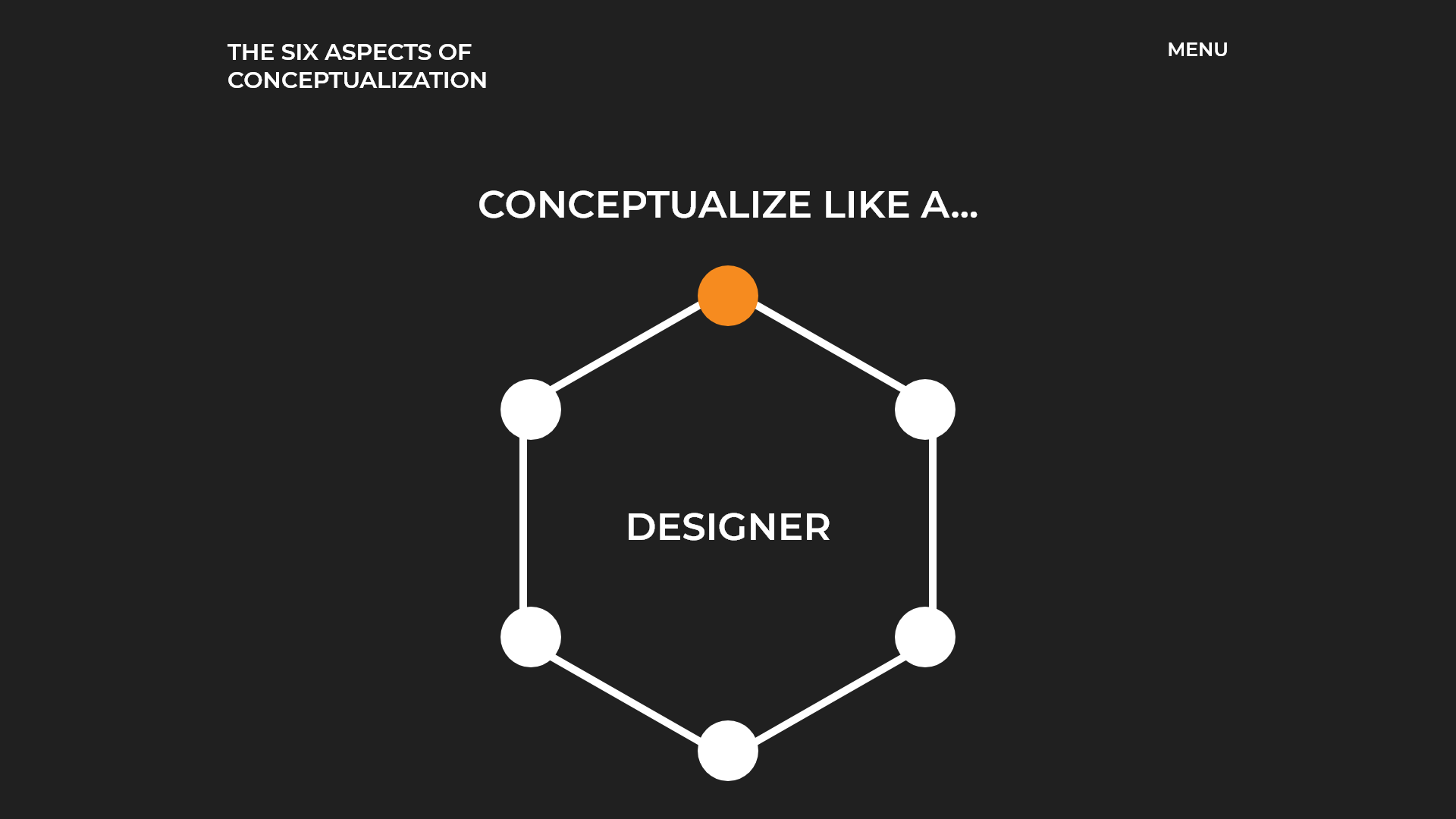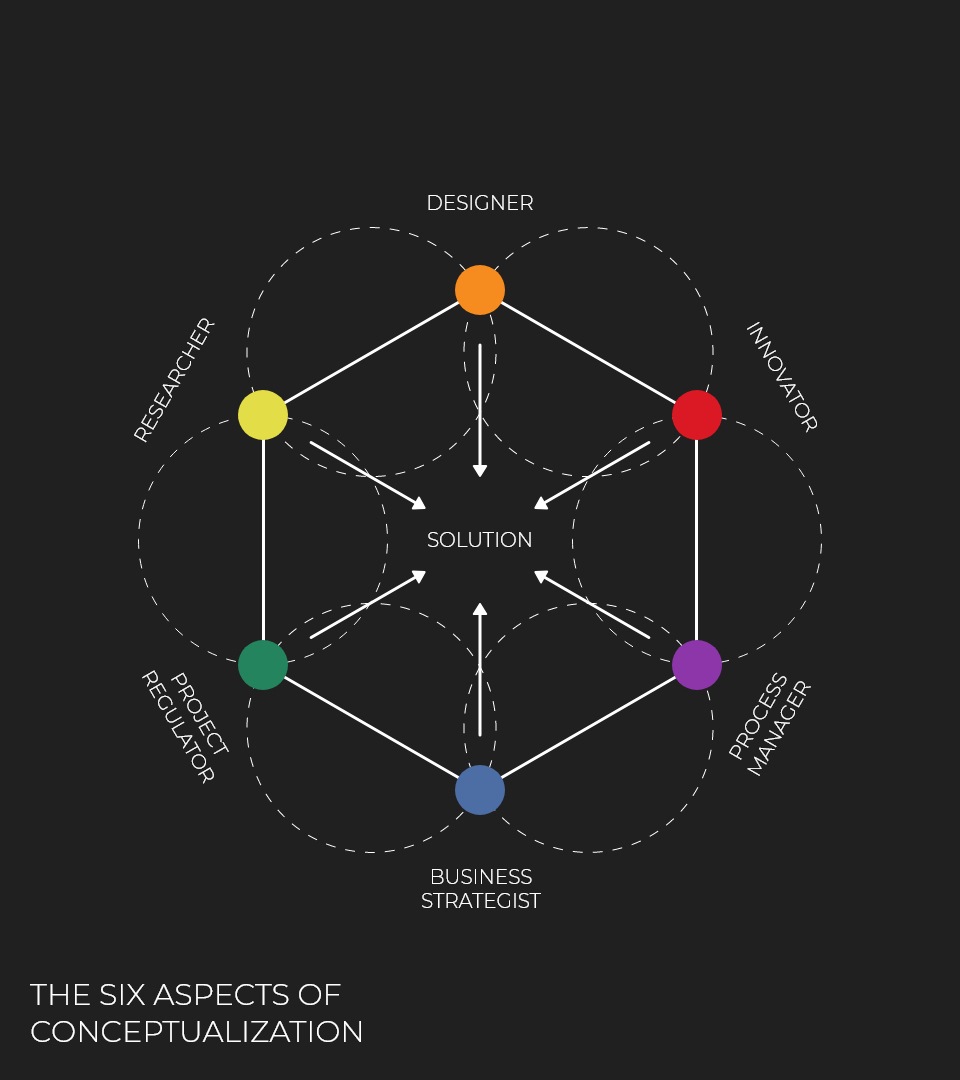The Six Aspects Of Conceptualization
Client //
Self-Initiated
Role //
Conceptualization, Design and Development
Timeframe //
Oct 2021 - May 2022
Link //
View Website
Overview
As part of my bachelor thesis for my study in Concept Development, I wanted to explore the area of tools and theories used in conceptualization. This included combining my knowledge of conceptualization with an added in-depth investigation and understanding of how conceptualization is used on a daily basis.
Problem statement:
‘How can tools and theories used in Concept Development be made accessible and operational in a digital product?’
Target groups:
- Concept Developers (Primary)
- Start-up Businesses (Secondary)
The project was based on a theoretical partnership with Senior UX Designer, Jon Yablonski, who is the creator of products like ‘Laws of UX’, ‘Humane By Design’ and ‘Biased By Design’.
The project itself was structurally based on Design Thinking and its five phases; Discovery, Interpretation, Ideation, Experimentation and Evolution. During the duration of the project I used multiple design methods, tools and theories in the exploration, ideation and creation of my concept, which would later be the same ones included in my product.
Discovery
As supplement to my understanding of Concept Development, I conducted additional research on conceptualization. Among other things, this included interviews and surveys on the two target groups, to get a more thorough understanding of their daily experiences with conceptualization.
These interviews and surveys were analyzed through the use of affinity diagrams.

Interpretation
Based on my research and understanding of Concept Development I started defining the areas of conceptualization - which later became The Six Aspects of Conceptualization. This included the creation of a mind map to visualize and structure my thoughts.

These six areas of conceptualization were then conceptualized further upon and made into six roles to describe the six aspects central to conceptualization of any project.

Ideation
My ideation phase included the use of several analysis methods to explore and define my concept. One of the first methods used was a value proposition canvas, focused on describing the customer segment and the value map of the concept solution.

Thereafter I created a mind map to structure the areas of the concept in order to make sure that all needs and must haves were provided for.

After this, a SWOT analysis was conducted on the concept to examine its position on the market.

The ARCS model was applied to explore the connectedness between the motivational aspects of attention, relevance, confidence and satisfaction, in relation to the concept.

And in the final steps before the experimentation phase, a future-state customer journey map and a service blueprint were made to guide the prototyping of the product.


Experimentation
The prototyping process included multiple iterations from the creation of structural wireframes, to visualized mockups and functional prototypes.




Based on the wireframes and mockups, the prototype was created. This too incorporated the content of tools and theories used in Concept Development.

After the creation of the index page of the prototype, I created the rest of the design, like the pages for each of the individual tools or theories.



Evolution
After the creation of the product prototype, a handful of accessibility and usability tests were conducted on the two target groups. The results of these user tests were later used in the improvement of the prototype.
Result
The project resulted in the creation of a conceptual solution on how to make tools and theories in concept development more accessible and operation for users.
Based on my research I went from an initial exploration of different types of conceptualization, based on the personality type of the person or team creating the concept. However, during my exploration and conceptualization on the topic itself, I came to the conclusion that in order to create the best possible concept and solution, one must consider all aspects of conceptualization, rather than just one path.
The models below showcase my vision for The Six Types of Conceptualization and The Six Aspects of Conceptualization.


As seen in the models above, The Six Types of Conceptualization would result in six different solutions, and could thus potentially lack in any of the other areas of conceptualization. The Six Aspects of Conceptualization on the other hand all focus on one solution, and would thus provide higher likelihood of being a more complete solution to the given problem.
The Six Aspects of Conceptualization does however look a little different in reality, as these six aspects are intertwined in the conceptualization process, rather than representing different phases of the process. I would therefore visualize the interconnectedness of The Six Aspects of Conceptualization like the model below.


Finally, I created this model overview of the tools used in concept development and visualized when each of these tools could be relevant to the phases of the Design Thinking process.
